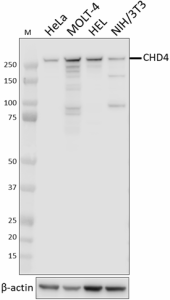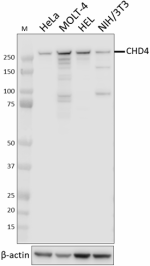- Clone
- W18333A (See other available formats)
- Regulatory Status
- RUO
- Other Names
- Chromodomain Helicase DNA Binding Protein 4, Mi2-β
- Isotype
- Rat IgG2a, κ
- Ave. Rating
- Submit a Review
- Product Citations
- publications

-

Whole cell extracts (15 µg protein) from the indicated cell lines were resolved by 4-12% Bis-Tris gel electrophoresis, transferred to a PVDF membrane, and probed with 1.0 µg/mL (1:500 dilution) purified anti-CHD4 antibody (clone W18333A) overnight at 4°C. Proteins were visualized by chemiluminescence detection using HRP goat anti-rat IgG antibody (Cat. No. 405405) at a 1:3000 dilution. Direct-Blot™ HRP anti-β-actin antibody (Cat. No. 664804) was used as a loading control at a 1:50000 dilution (lower). Lane M: Molecular weight marker. -

HeLa cells were fixed with 4% paraformaldehyde for 10 minutes, permeabilized with methanol for 6 minutes, and blocked with 5% FBS for 60 minutes. Cells were then intracellularly stained with 5.0 µg/mL (1:100 dilution) either rat IgG2a, κ isotype ctrl antibody (Cat. No. 400502) (panel A) or purified anti-CHD4 antibody (clone W18333B) (panel B) followed by incubation with Alexa Fluor® 594 goat anti-rat IgG antibody (Cat. No. 405422) at 2.0 µg/mL (1:250 dilution). Nuclei were counterstained with DAPI, and the image was captured with a 60X objective.
| Cat # | Size | Price | Save |
|---|---|---|---|
| 942301 | 25 µg | ¥25,960 | |
| 942302 | 100 µg | ¥64,460 |
Chromatin-helicase-DNA-binding (CHD) proteins are highly conserved chromatin-remodeling enzymes that can function in transcriptional activation, repression, and DNA repair. CHD family members are generally components of multi-subunit complexes, with interacting partners dictating repressive or activating function. CHD4 is a critical component of the nucleosome remodeling and histone deacetylation (NuRD) complex. Aberrant expression of CHD4 is linked to multiple types of cancer and functions as an oncogene in breast and colorectal cancers. Mutations in CHD4 cause Sifrim-Hitz-Weiss syndrome.
Product DetailsProduct Details
- Verified Reactivity
- Human, Mouse
- Antibody Type
- Monoclonal
- Host Species
- Rat
- Immunogen
- Partial recombinant human CHD4 protein
- Formulation
- Phosphate-buffered solution, pH 7.2, containing 0.09% sodium azide
- Preparation
- The antibody was purified by affinity chromatography.
- Concentration
- 0.5 mg/mL
- Storage & Handling
- The antibody solution should be stored undiluted between 2°C and 8°C.
- Application
-
WB - Quality tested
ICC - Verified - Recommended Usage
-
Each lot of this antibody is quality control tested by western blotting. For western blotting, the suggested use of this reagent is 0.25 µg/mL. For immunocytochemistry, a concentration range of 1.0 - 5.0 μg/mL is recommended. It is recommended that the reagent be titrated for optimal performance for each application.
- Application Notes
-
During product development testing for western blot, we observed additional bands below the predominant, full-length CHD4 band. These additional bands were also detected using a CHD4 antibody raised using a separate immunogen. We therefore believe these bands represent CHD4 degradation products or additional CHD4 isoforms.
This clone was tested for ICC using 4% PFA-fixed HeLa cells permeabilized with either Triton X-100 or methanol. While both methods were compatible with robust CHD4 staining, we observed punctate, extranuclear staining of cells permeabilzed with Triton X-100. We therefore do not recommend this method when using the clone for ICC. - RRID
-
AB_2888898 (BioLegend Cat. No. 942301)
AB_2888898 (BioLegend Cat. No. 942302)
Antigen Details
- Structure
- CHD4 is a 1,912 amino acid protein with a predicted molecular weight of 218 kD.
- Distribution
-
Ubiquitously expressed/Nucleus
- Function
- Chromatin modifying enzyme
- Biology Area
- Cell Biology, Chromatin Remodeling/Epigenetics
- Antigen References
-
- Arends T, et al. 2019. Proc Natl Acad Sci U S A. 116:10927-10936.
- Xia L, et al. 2017. Cancer Cell. 31:653-668.
- Weiss K, et al. 2016. Am J Hum Genet. 99:934-941.
- Gene ID
- 1108 View all products for this Gene ID
- UniProt
- View information about CHD4 on UniProt.org
Related Pages & Pathways
Pages
Related FAQs
Other Formats
View All CHD4 Reagents Request Custom Conjugation| Description | Clone | Applications |
|---|---|---|
| Purified anti-CHD4 | W18333A | WB,ICC |
Compare Data Across All Formats
This data display is provided for general comparisons between formats.
Your actual data may vary due to variations in samples, target cells, instruments and their settings, staining conditions, and other factors.
If you need assistance with selecting the best format contact our expert technical support team.










Follow Us